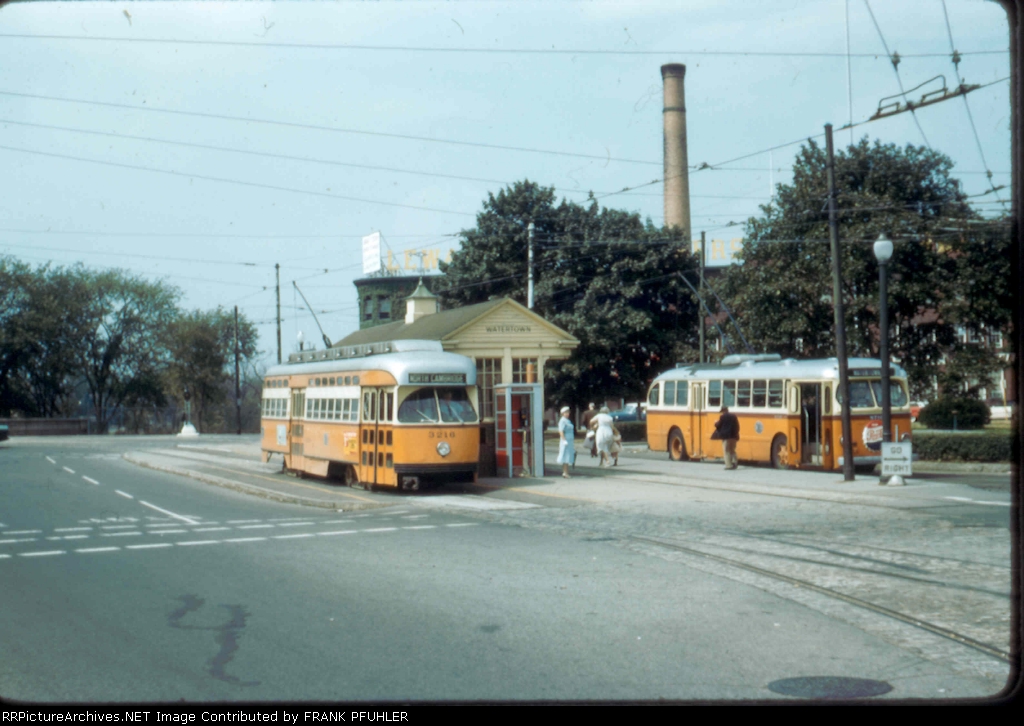A question note entirely related to this thread but: how exactly did streetcars switch tracks when they were embedded in the street? With conventional rail you have a switch which moves a track but you can't do that in the street.
Oh, streetcar switches are automatic too. On
this one on South Huntington that switches for Heath inner vs. outer loops you can see the electrical box covers in the roadway. Right next to it about 1 ft. up you can see the actual turning switch mechanism on the left rail, which grabs the front left wheel. The right rail has no switch and is just a straight split frog, so when the left wheels get dragged left onto the inner loop the right wheels bank left with it. A right-turning switch would be configured the opposite: grab the right wheels with the turning switch, drag the left wheels through the open frog. This switch has a manual backup which you can see as a little slot in the ground next to the moving switch. Staff can hand-throw it with a metal rod that has a turning bolt at the end, and the little guard shack at Heath has switch rods always available in the storage closet.
The means for throwing the switch is deceptively simple. Operator coasts thru for going straight, powers thru for turning. There's an insulated section of overhead wire right before the switch fitted with a voltage detector that catches either the spike in power draw or lackthereof to trigger the switch. The switch then auto-resets itself back to the default position on a short delay after the voltage detector picks up the safe passage of the trolley out of the insulated section. Coast vs. power-thru has been universal practice from Day 1 of electrified streetcars to today, and every light rail and TT system on the planet that's in mixed-running outside of the signal system's control still operates this way. So on that linked Street View pic at Heath, the Type 8 sitting on the inner loop did a power-thru move at the switch to get there, while the Type 7 at the front of the outer loop coasted thru. If the Breda was last through the switch, then the switch has already auto-reset itself as it's back in the default "straight ahead" position for the outer loop. When Arborway service was still running through this spot there were simply two switches staggered in close succession such that during pre-1985 rush hour when the line was doubled-up in service with every-other train Arborway vs. Heath short-turns, the Arborway trains did a "coast + coast" maneuver to go straight, outer-loop Heath turning trains did "coast + power" thru both switches, and inner-loop Heath turning trains did "power" at the first switch only. A/B Line split at Packards Corner was power-thru for B right up to when the emergency 2-car pocket track on Brighton Ave. was torn out circa 2000, with the cut-out section positioned relative to the traffic light so the operator could get a short running start before making their pick.
With trolley pole or TT overhead you'll have reciprocal switchboxes on the overhead because of the way the poles grab the wire, so TT's operate on the same coast vs. power-thru maneuver. And it's easier to watch happen on TT's or Silver Line because the overhead switches make an audible click when they change directions that you won't hear on a default-direction coast-thru. Pantograph wire is much more simply welded-together at junction points with no wire switchboxes, but operates the same exact way. You will see little "Cut Out" signs hung on the wire hangers all over the TT system indicating where the switch cutouts and voltage dectors are. Green Line used to have those signs when all overhead on the system was still dual pole/pantograph compatible for co-mingled LRV & PCC running, but they disappeared when all the overhead across the system was renewed to pantograph-only in the late-90's in prep for the Type 8's.
Most surface switches on Green and Mattapan operate this way, including all the ones on the reservation. Central dispatch is not required to get around. Only exceptions are Blandford St. Yard controlled from the guard shack, the Brigham Circle crossovers controlled from the guard shack when service is short-turning, and some very seldom-used crossovers (all on the reservation, no in-street crossovers left) that are hand-throw because they're only practically used on the work shift. Chestnut Hill Ave. street trackage also has at least one hand-throw only switch amid its majority-automatic collection, as the eastbound wye onto the B was taken out of service several few years ago after a Type 8 wrecked and burned itself splitting a switch. Only the CH Ave. north to B Line east track is still connected, so that now emergency-only switch was downgraded to hand-throw.
EDIT: Actually, scroll straight up to the sky in the Street View shot and you can see the "Cut Out" sign on the wire hanger about a foot away from a couple extra jumper wires. That's the insulated section with the voltage detector. So when the Type 8 sitting on the inner loop was approaching a few feet behind that spot the detector caught the power draw surge coming through the overhead from the oncoming trolley as the operator was working the throttle on power-thru, then auto-threw the switch for the inner loop. When the Type 7 on the outer platform approached from that same spot the detector felt no surge in power because the operator was coasting, so the switch was not thrown and stayed fixed in the default straight-ahead position for the outer loop.


